If you haven’t tried OREO Mochi yet, you’re seriously missing out on one of the most mouthwatering dessert mashups to hit American kitchens in recent years. This chewy, creamy, chocolatey delight blends the iconic crunch of OREO cookies with the soft, stretchy texture of traditional Japanese mochi—creating a sweet experience that’s equal parts nostalgic and exotic.
I first stumbled upon OREO Mochi during a trip to a local fusion bakery in Los Angeles. The mochi caught my eye, but the OREO filling stole my heart. I thought, Why not try making this at home? That single bite sparked a personal mission to understand what made this dessert so addictive—and how I could recreate (and even elevate) it in my own kitchen.
In this article, I’ll walk you through everything you need to know about OREO Mochi—from its surprising cultural blend and unique ingredients, to how you can make it right in your own home without using alcohol or pork-based products. We’ll dive into fun recipe twists, where to buy it in the U.S., and even take a sneak peek into upcoming 2025 OREO flavors perfect for mochi innovation.
Whether you’re a mochi lover, an OREO fanatic, or someone just hunting for a fun dessert to impress your friends, this guide is for you. So, let’s jump into the chewy, chocolate-filled world of OREO Mochi!
Looking for inspiration? Try these mochi-friendly recipes like Nama Chocolate for indulgent, no-bake treats
Table of Contents
What is OREO Mochi and Why It’s Blowing Up Online
The Origins of OREO and Mochi: A Cultural Collision
OREO Mochi might sound like a TikTok gimmick, but trust me—it’s more than just a fleeting trend. To understand how we got this chewy-chocolate hybrid, we’ve got to look at its roots.
Mochi has been a staple of Japanese cuisine for centuries, crafted from glutinous rice pounded into a stretchy, soft dough. Traditionally used in New Year’s ceremonies and religious rituals, mochi evolved into sweet confections like daifuku—soft rice cakes filled with red bean paste or fruit.
On the other side of the world, OREO cookies, created in 1912 by the National Biscuit Company (now Nabisco), became an American icon. Crunchy, chocolatey, and creamy, the OREO has inspired everything from ice cream to pie crusts.
Now imagine blending these two food icons: the cultural sophistication of mochi with the childlike delight of an OREO. That’s what OREO Mochi is all about—a fusion that bridges East and West, nostalgia and novelty.
This sweet collision didn’t happen in a vacuum. It rose from a growing global appetite for cross-cultural culinary experiments. When people like you and me got curious, adventurous, and a little daring in our kitchens, something magical was born.
How This Dessert Trend Became a Viral Sensation
So why is everyone suddenly obsessed with OREO Mochi? The answer is simple: texture + taste = addicting.
Bite into it, and you’re hit with the soft, elastic pull of sweet rice dough, followed by the unexpected crunch and creamy cocoa filling of a crushed OREO center. That mix of chewy and creamy, earthy and sweet, has made it a hit among food bloggers, YouTubers, and Instagram chefs alike.
Social media has played a major role in catapulting OREO Mochi into dessert fame. TikTok videos showing the satisfying stretch and dramatic reveals of the gooey inside have racked up millions of views. Foodies are customizing the recipe with colored doughs, flavored fillings, and even edible glitter.
It’s not just hype, either. The demand for OREO Mochi has skyrocketed in both online and brick-and-mortar bakeries across the U.S. I’ve even seen pre-packaged versions at my local Asian market—though I always say homemade is best.
From its humble beginnings in two different cultures to its explosion on American smartphones and menus, OREO Mochi is more than a treat—it’s a movement. And it’s just getting started.
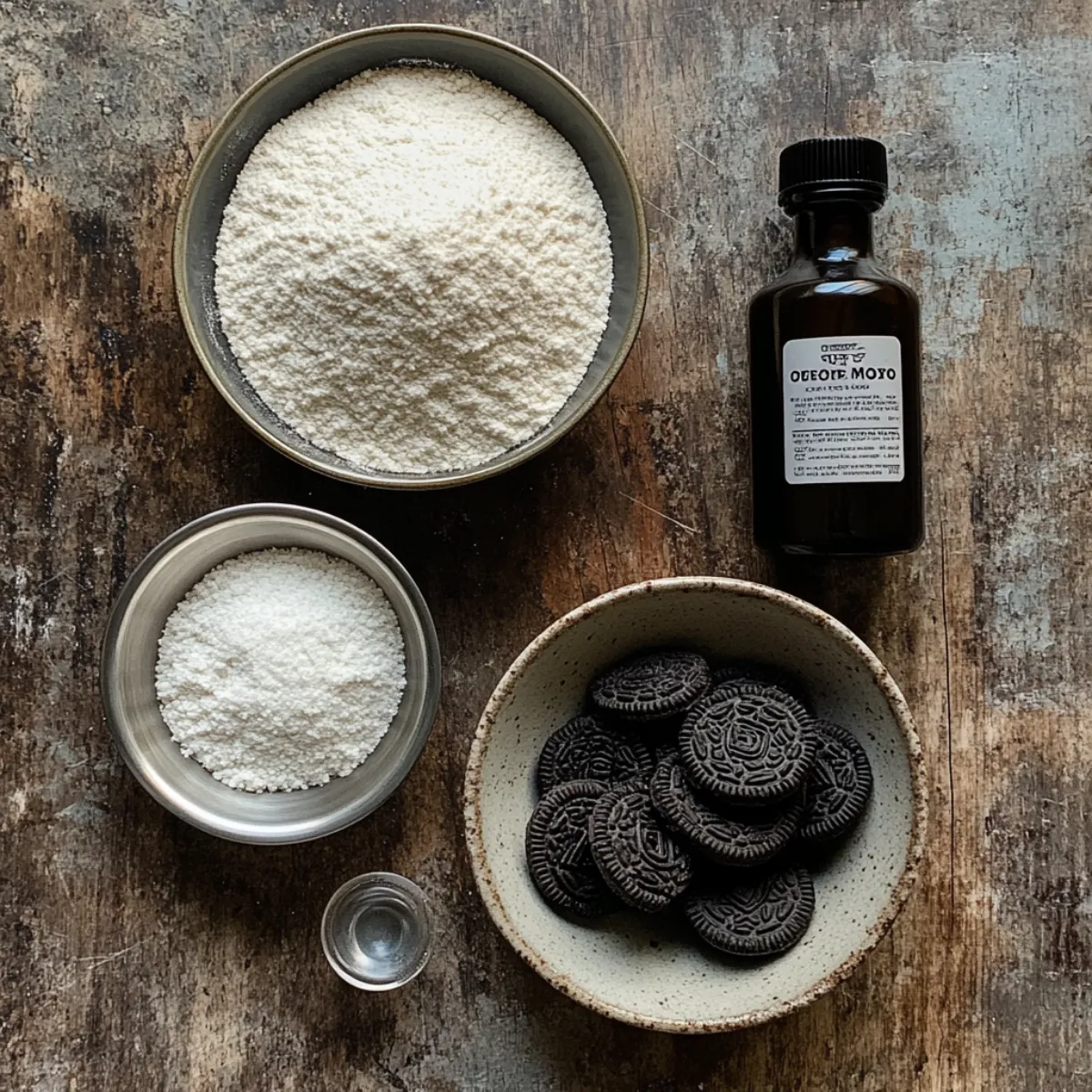
Inside the Ingredients: What Goes Into OREO Mochi
The Core Ingredients That Define OREO Mochi
When you hear “OREO Mochi,” it might sound like a complex culinary fusion. But here’s the truth—it’s made from just a handful of accessible ingredients, and each one plays a crucial role in creating that perfect chewy-crunchy bite.
Let me break it down:
| Ingredient | Purpose in the Recipe |
|---|---|
| Sweet Rice Flour (Mochiko) | The base for the mochi dough, giving it its signature stretch |
| Sugar | Sweetens the dough and enhances chewiness |
| Cornstarch | Prevents sticking during shaping and rolling |
| Milk (or non-dairy milk) | Adds moisture to make the mochi tender |
| Crushed OREO Cookies | The flavorful, crunchy filling |
| Vanilla Extract | Optional, but enhances flavor depth |
The magic really comes alive when the OREO filling meets the gooey mochi dough. It’s like biting into a pillowy cloud that surprises you with a hit of chocolate cookie crunch and cream.
A fun twist? Try freezing your OREO cream centers separately and then stuffing them into the mochi for a creamy center that doesn’t melt during steaming or microwaving.
Substituting Pork and Alcohol-Free Alternatives in Mochi Recipes
One of the first things I learned while experimenting with OREO Mochi is that some recipes online sneak in non-halal ingredients—often in the form of gelatin, bacon bits (yup, even in desserts), or flavored alcohol.
In my kitchen, I always stay conscious of keeping it clean, inclusive, and respectful of different dietary needs. So, I replace those ingredients quietly but thoughtfully.
Instead of gelatin, I use agar-agar or simply rely on the natural texture of sweet rice flour. As for alcohol-based flavor extracts (like bourbon vanilla), I swap them out for pure vanilla or almond extract that’s alcohol-free.
And if any recipe dares include pork-based ingredients like bacon crumble (I’ve seen it!), I leave it out altogether and enhance flavor with crushed roasted nuts or toasted coconut flakes for extra crunch.
You won’t even notice the difference—and in many cases, the flavor improves when you use natural, wholesome alternatives. That’s what makes homemade OREO Mochi not just delicious, but feel-good food.
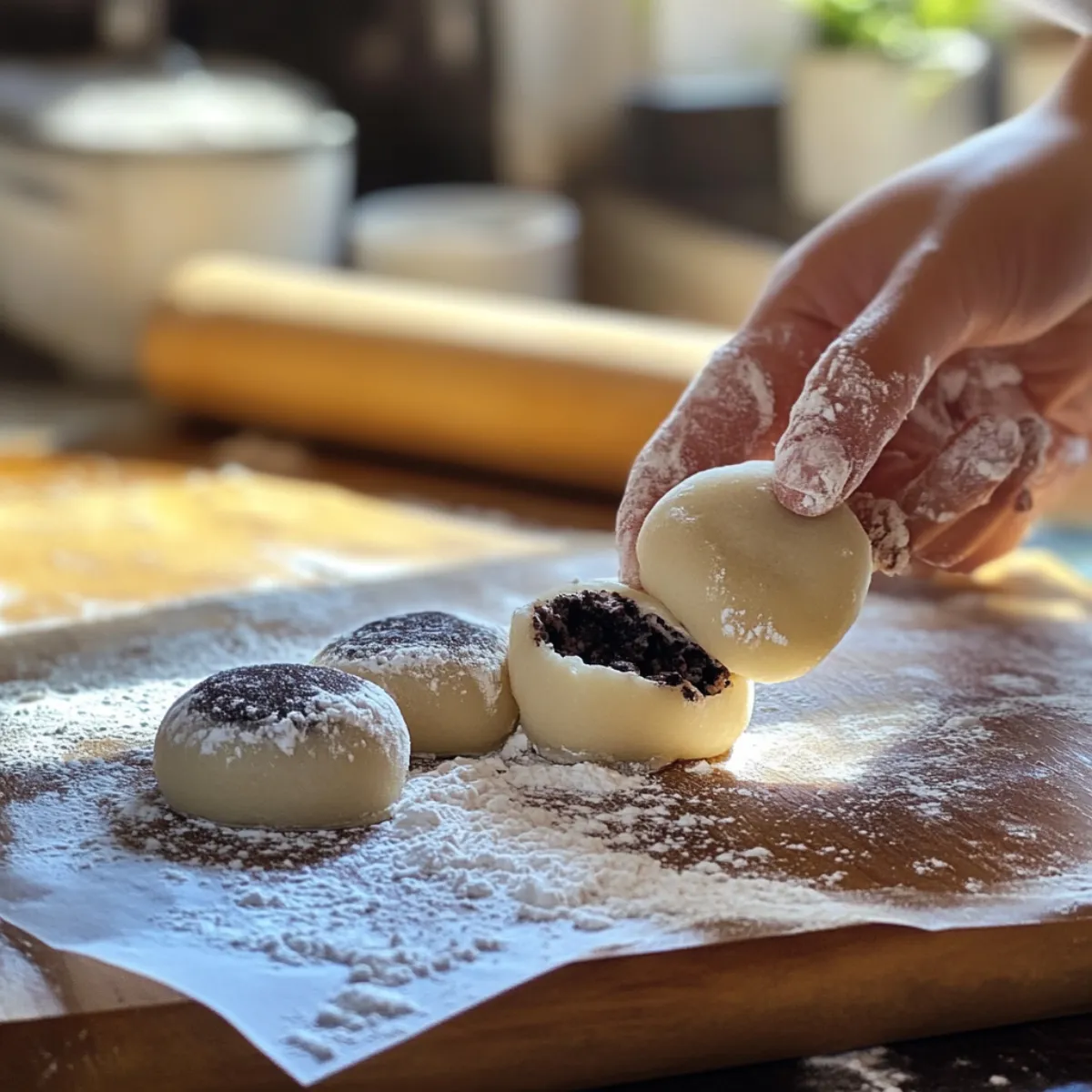
How to Make OREO Mochi at Home (Step-by-Step Recipe)
Ingredients You’ll Need
I’ve tested this recipe over and over, and I promise—it’s not only beginner-friendly but also adaptable if you’re avoiding pork or alcohol-based ingredients. Here’s what I use every time for a chewy, chocolatey mochi bite that disappears fast in my house:
Dough:
- 1 cup sweet rice flour (Mochiko or Shiratamako)
- 1/4 cup granulated sugar
- 3/4 cup milk (or non-dairy milk like almond or oat)
- 1/4 teaspoon alcohol-free vanilla extract
- Cornstarch or potato starch (for dusting)
Filling:
- 10 OREO cookies, crushed (separate cream and cookie if preferred)
- 2 tablespoons cream cheese (optional, for creamy filling)
- Crushed roasted almonds or toasted coconut flakes (optional)
Tools:
- Microwave-safe bowl or steamer
- Rolling pin (or clean hands!)
- Plastic wrap or parchment
- Spoon or cookie scoop
Pro Tip: Freeze small scoops of the cream + crushed OREO mix ahead of time. It makes stuffing the mochi easier and prevents the filling from leaking.
Easy Preparation Method Even Beginners Can Follow
Let me walk you through the steps. Don’t worry—I’m not a professional chef either. This is just me, Sifaw, learning by trial, error, and pure dessert love.
Step 1: Make the Filling
Crush your OREOs and mix them with a spoon of cream cheese or just the cookie cream if you separated it earlier. Scoop into teaspoon-sized balls and freeze for 15–20 minutes.
Step 2: Make the Mochi Dough
In a microwave-safe bowl, mix sweet rice flour, sugar, milk, and vanilla extract. Stir until smooth and free of lumps.
Microwave the mixture for 1 minute. Stir. Microwave again for 30 seconds, stir again, and repeat one more time. By now, it should be a sticky, semi-translucent dough.
No microwave? Steam it for 15–20 minutes, stirring once halfway through.
Step 3: Shape and Fill
Dust your work surface and hands with cornstarch. Scoop about a tablespoon of the mochi dough, flatten it gently, and place your frozen filling in the center. Pinch the dough around the filling and roll into a ball.
Repeat until all your mochi are shaped.
Step 4: Chill and Serve
Place the finished mochi balls on parchment and chill in the fridge for 15–30 minutes. Serve cold or at room temperature.
And there you have it! Your very own OREO Mochi—chewy, chocolatey, and absolutely unforgettable.
Discover great ideas like this Ube Cheese Pie if you’re craving more sweet, chewy textures.
Exploring OREO Mochi Variations for Every Sweet Tooth
Vegan, Gluten-Free, and Dairy-Free OREO Mochi Options
Let’s face it—not everyone can or wants to enjoy dairy or gluten. But that doesn’t mean you have to miss out on this chewy-chocolate masterpiece. I’ve tried several variations over the years for friends with dietary needs, and these are some of my top-tested swaps.
| Dietary Need | Smart Substitution |
|---|---|
| Dairy-Free | Use unsweetened almond milk or oat milk |
| Vegan | Choose plant-based OREO-style cookies and dairy-free cream cheese (like cashew or coconut-based) |
| Gluten-Free | Ensure you’re using gluten-free OREO alternatives (available in many stores now) |
OREOs themselves are technically vegan in the U.S., but check the labels just to be safe. For the mochi dough, you’re already in the clear—sweet rice flour is naturally gluten-free.
Sometimes I’ll even go a little wild and stuff the mochi with a scoop of vegan chocolate ganache made from coconut cream. The texture is dreamy, and the richness pairs so well with the chewy rice shell.
Want to go fruity? Add some freeze-dried raspberries to your crushed OREO filling. It cuts the sweetness and adds a tangy pop!
OREO Mochi Ice Cream, Filled Mochi & More
Let me tell you—OREO Mochi isn’t just a one-hit wonder. Once you’ve mastered the basic technique, you can explore a whole universe of fun.
Here are a few variations I’ve made at home:
- OREO Mochi Ice Cream
Freeze small scoops of vanilla ice cream mixed with crushed OREOs. Wrap with chilled mochi dough and freeze again. It’s like biting into dessert heaven. - OREO Peanut Butter Mochi
Mix crushed OREOs with natural peanut butter for a nutty, salty-sweet center. One of my absolute favorites! - Double Chocolate OREO Mochi
Add a tablespoon of unsweetened cocoa powder to your mochi dough and fill it with white chocolate chips + OREO chunks. It’s decadent, rich, and kid-approved. - Matcha OREO Mochi
Stir matcha powder into the mochi dough for a grassy, earthy contrast to the sweet cookie center. The green color makes them look super vibrant too.
Every twist is another excuse to share a batch with someone you love—or to keep them all to yourself (no judgment from me).
Check out this Strawberry Angel Food Cake for a fruity twist that complements mochi-based desserts beautifully.
Taste Test: What Does OREO Mochi Actually Taste Like?
Texture, Flavor, and Why People Love It
When people bite into OREO Mochi for the first time, the reaction is almost always the same: wide eyes, slow chew, and a smile that says “what just happened in my mouth?”
I’ll be honest—I didn’t expect to love it the first time I made it. I thought it might be a little gimmicky. But wow, was I wrong.
Here’s how I’d describe it:
- Texture: Soft and chewy on the outside, slightly elastic like a marshmallow that hugs your bite. Then you hit the inside—a creamy, crumbly center with crushed OREO cookies. The contrast is everything.
- Flavor: The mochi dough is lightly sweet, neutral enough to let the filling shine. The OREO center delivers that deep cocoa flavor with hints of vanilla cream. Depending on your filling (like peanut butter or matcha), you can tilt the taste in fun new directions.
People love it because it hits multiple cravings at once: chewy, creamy, sweet, slightly salty, and even a bit nostalgic if you grew up on OREOs. Plus, it’s handheld and photogenic, which never hurts.
When I serve OREO Mochi at family dinners or parties, it disappears faster than anything else. Even folks who claim they don’t like “weird” textures end up asking for seconds.
Comparing Store-Bought vs Homemade OREO Mochi
I’ve tried both, and trust me, the difference is noticeable.
| Category | Homemade OREO Mochi | Store-Bought OREO Mochi |
|---|---|---|
| Texture | Softer, fresher, more elastic | Often drier, sometimes rubbery |
| Flavor | Richer and more customizable | Standardized; less intense OREO flavor |
| Ingredients Control | Full control (no pork or alcohol) | Check labels—some contain gelatin or additives |
| Cost | Budget-friendly, especially in batches | More expensive per piece |
If you’re buying from a trusted bakery, it can be great. But honestly? Making it yourself is worth it—especially when you’re feeding a group or want to adjust the recipe to match your preferences (or dietary needs).
You get fresher flavor, fuller texture, and the joy of saying, “Yep, I made that.” And believe me, that joy adds a little something extra to every bite.
Don’t miss our collection of heartwarming recipes designed to delight dessert lovers.
Where to Buy OREO Mochi in the USA (and Online)
Best Retailers and Online Stores
Now, as much as I love making OREO Mochi from scratch, I get it—sometimes you just want that chewy goodness now. Thankfully, this trend has grown big enough that it’s not too hard to find, especially if you know where to look.
Here are some of the top places I’ve bought (and enjoyed!) store-bought OREO Mochi:
| Retailer | Type | Availability |
|---|---|---|
| Trader Joe’s | Grocery Store | Often carries mochi with seasonal flavors |
| Whole Foods | Premium Grocery | May carry mochi with OREO-like cookies |
| H Mart / 99 Ranch Market | Asian Supermarkets | Great selection of frozen mochi, including OREO flavors |
| Amazon | Online Retailer | Wide selection, check reviews for quality |
| My/Mochi Website | Brand Website | Carries official Oreo-inspired flavors |
Some regional bakeries are also getting in on the trend. I found a small shop in San Diego that makes homemade OREO Mochi stuffed with matcha cream. Let me tell you—it was worth every penny.
Before buying, always check the ingredient list if you’re avoiding pork, gelatin, or alcohol-based flavorings. Some pre-packaged brands may sneak them in.
How to Spot Quality and Avoid Overpriced Brands
Here’s a little guide I’ve learned through trial and error. Not all OREO Mochi is created equal—especially when ordering online or from unfamiliar brands.
Signs of good quality:
- Dough looks soft and slightly matte (not shiny and rubbery)
- Minimal preservatives
- Real OREO or chocolate cookie listed in ingredients
- No artificial alcohol-based flavoring
Red flags to watch out for:
- Overly stiff mochi shells (means it’s old or frozen too long)
- Weirdly bright colors (may indicate artificial dyes)
- “Chocolate-flavored filling” without actual cocoa or cookie crumbs
When in doubt, go for smaller batch brands or check foodie reviews. I always search Instagram for tagged posts before buying online. Real customer photos don’t lie.
OREO Mochi vs Traditional Mochi: What’s the Difference?
Key Differences in Taste, Texture, and Ingredients
At first glance, OREO Mochi and traditional mochi may seem similar. They’re both soft, chewy rice doughs with sweet fillings. But once you taste them side by side, the contrast is surprisingly distinct.
Let me break it down from my kitchen experiments and dessert tastings over the years:
| Feature | Traditional Mochi | OREO Mochi |
|---|---|---|
| Filling | Red bean paste, fruit, matcha, sesame | Crushed OREO cookies, cream cheese, chocolate |
| Dough Flavor | Neutral or slightly sweet | Often slightly sweeter, sometimes flavored (e.g., vanilla or cocoa) |
| Texture | Soft and chewy with occasional elasticity | Chewy outside with a creamy-crunchy center |
| Cultural Use | Ceremonial, seasonal (New Year, weddings) | Trendy, snack-style dessert |
| Appearance | Simpler, muted colors | Fun, playful, sometimes colorful or dusted |
While traditional mochi honors centuries-old culinary traditions, OREO Mochi is a modern fusion dessert built for Instagram, parties, and curious taste buds. And you know what? There’s space for both.
I love serving traditional daifuku mochi for quiet, mindful moments. But when I want to make my nephews smile or impress guests, I whip up OREO Mochi with a side of storytelling.
Cultural Perspective: Mochi in Japan vs the Western Take
In Japan, mochi holds deep cultural significance. It’s a symbol of prosperity, tradition, and community. It’s served during the Japanese New Year (Oshogatsu), at weddings, and even in spiritual ceremonies.
The preparation of traditional mochi—called “mochitsuki”—is often a communal event, involving rhythmic pounding of steamed rice with wooden mallets. It’s as much about bonding as it is about food.
Now, fast-forward to the West, where mochi has transformed into a trendy dessert category. From mochi donuts to ice cream mochi and now OREO Mochi, the focus is often on novelty and texture play.
While some purists may turn up their noses at these modern versions, I believe there’s beauty in evolution. We’re not replacing tradition—we’re celebrating it with curiosity and creativity.
Besides, if something as simple as mochi can connect cultures and generations? That’s a win in my book.
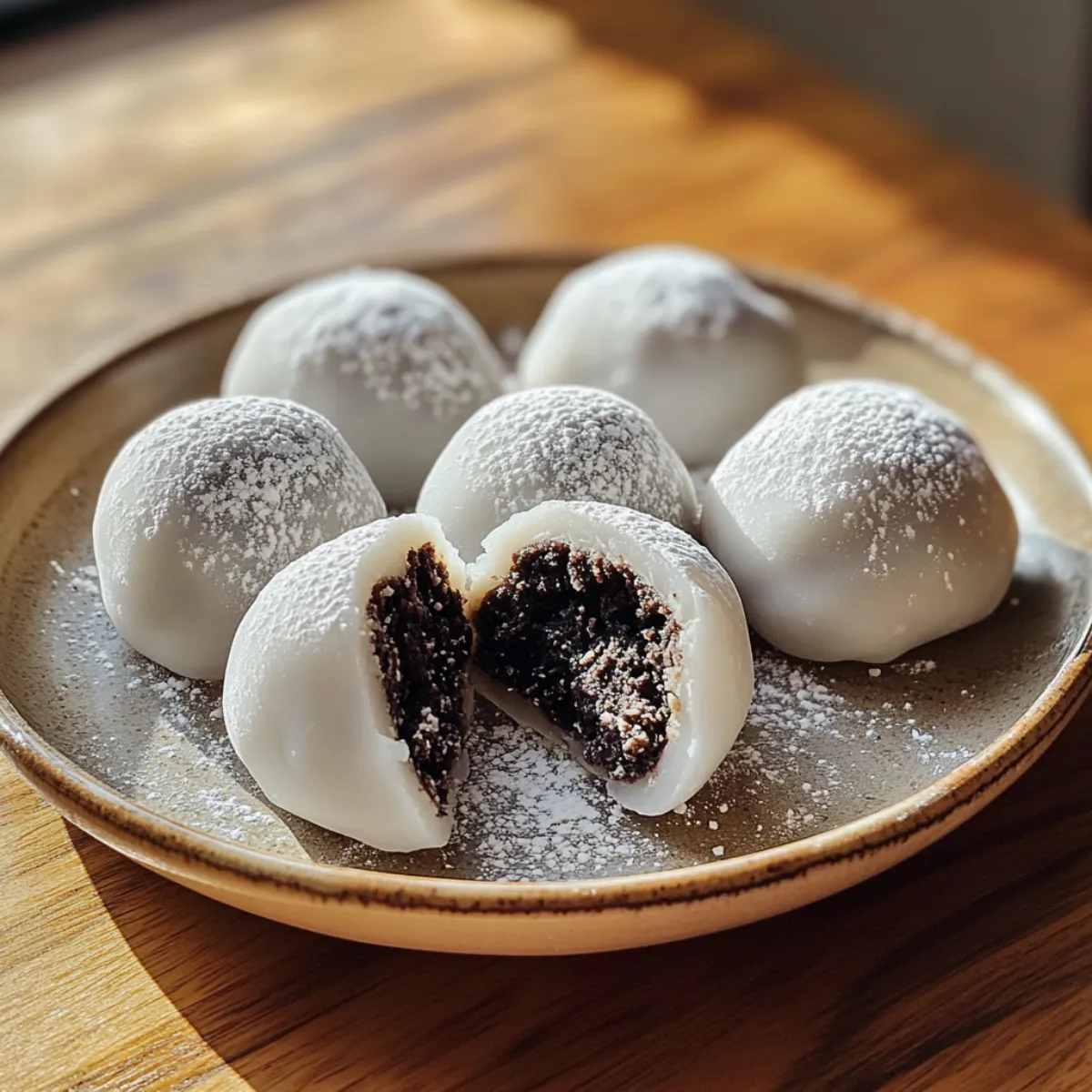
2025 Flavor Innovations: New OREO Mochi Combos to Watch
Upcoming OREO Flavors You Can Expect in Mochi Form
Each year, OREO drops a lineup of limited-edition flavors that make dessert fans like me absolutely giddy. And 2025? It’s shaping up to be a flavor goldmine. Let’s talk about which ones could work perfectly in mochi form.
Based on my early tastings and a few industry previews, here are the flavors I’m most excited to experiment with in my mochi dough:
| New OREO Flavor (2025) | OREO Mochi Twist Idea |
|---|---|
| Strawberry Matcha Swirl | Fill mochi with strawberry jam + matcha cream center |
| Churro Delight | Cinnamon-sugar dusted mochi with OREO churro cream inside |
| S’mores Reloaded | Graham cookie crumbs + marshmallow fluff in the center |
| Mango Lassi | Tropical mango puree with vanilla mochi shell |
| Dark Chocolate Sea Salt | Intensely rich cocoa dough with salty chocolate ganache |
I get butterflies just thinking about how that Strawberry Matcha Swirl OREO could turn into a vibrant, tart-sweet mochi ball. Or how that Churro Delight might taste warm, soft, and dusted with cinnamon.
One trick I love? Blending real fruit or matcha powder into the mochi dough itself to highlight the flavor even more.
DIY Flavor Twists You Can Try at Home
You don’t need to wait for the shelves to stock the newest OREOs. Here are a few mochi mashups I’ve made at home with some pantry staples and imagination:
- Cookies & Cream Mochi: Blend crushed OREOs into the mochi dough itself for a double-cookie experience.
- Caramel Apple OREO Mochi: Mix spiced apple compote with OREO thins and a drizzle of caramel inside.
- Pumpkin Spice Mochi: For fall vibes, add pumpkin puree and cinnamon to the dough, then fill with golden OREOs.
Want to get fancy? Try color-coordinating your doughs using natural powders—like beetroot (for pink), turmeric (for yellow), or activated charcoal (for black-and-white themes). Kids love it, and it’s super fun to make.
You don’t have to be a pastry chef—just be playful. The magic of OREO Mochi is that it leaves room for creativity, mistakes, and unforgettable discoveries.
FAQs About OREO Mochi Answered
Is mochi just smashed rice?
Not quite. While mochi does come from glutinous rice, it’s not simply “smashed.” Traditional mochi is made by steaming short-grain glutinous rice and then pounding it with wooden mallets until it becomes a stretchy, smooth dough. This process, called mochitsuki, creates that unique chewy texture mochi is famous for.
Modern mochi recipes, including OREO Mochi, often use sweet rice flour (like Mochiko) instead of whole rice. It’s quicker, more consistent, and just as delicious.
What is mochi made of?
At its core, mochi is made from glutinous rice or glutinous rice flour, also called “sweet rice” (not because it’s sugary, but because of its sticky nature). The basic recipe usually includes:
Sweet rice flour (like Mochiko)
Sugar
Water or milk
Cornstarch (for dusting)
In the case of OREO Mochi, we add crushed OREO cookies, sometimes blended with cream cheese or nut butters, to create a rich, indulgent filling. You can also mix flavors into the dough—like cocoa, matcha, or vanilla—for extra personality.
What are the new OREO flavors 2025?
OREO keeps surprising us every year, and 2025 is no exception. Some confirmed and rumored flavors that dessert fans are buzzing about include:
Strawberry Matcha Swirl
Churro Delight
Mango Lassi
S’mores Reloaded
Dark Chocolate Sea Salt
Each of these flavors is a perfect candidate for mochi innovation. Imagine a strawberry-mocha dough with a mango center, or cinnamon-sugar dusted mochi balls stuffed with churro cream. The possibilities for homemade OREO Mochi are endless—and delicious.
Is mochi just smashed rice?
OREO keeps surprising us every year, and 2025 is no exception. Some confirmed and rumored flavors that dessert fans are buzzing about include:
Strawberry Matcha Swirl
Churro Delight
Mango Lassi
S’mores Reloaded
Dark Chocolate Sea Salt
Each of these flavors is a perfect candidate for mochi innovation. Imagine a strawberry-mocha dough with a mango center, or cinnamon-sugar dusted mochi balls stuffed with churro cream
Why are mochis so expensive?
This one hits close to home. Mochi often seems pricey for something that looks small and simple. But here’s why:
Ingredient Cost: Glutinous rice and high-quality fillings (like matcha, red bean, or chocolate ganache) aren’t cheap.
Labor-Intensive Process: Even with modern tools, mochi is delicate and handmade. The dough must be handled quickly and carefully to maintain the texture.
Shelf Life: Mochi is best fresh, which means small-batch production, limited shipping, and less mass manufacturing.
That’s why making your own OREO Mochi at home is such a win—you save money and get a fres
Conclusion: Why You Should Try Making OREO Mochi Today
If you’ve made it this far, you’re clearly as fascinated by OREO Mochi as I was the first time I bit into one. This isn’t just a dessert—it’s an edible experience, a cross-cultural creation that bridges chewy Japanese tradition and America’s most beloved cookie.
But more than that, it’s fun to make, endlessly customizable, and surprisingly accessible—even if you’re not a seasoned cook.
I still remember my first homemade batch. I burned the first dough in the microwave, forgot to dust the table with starch, and had OREO filling leaking everywhere. But by the second round? I had something that not only tasted amazing—it made my friends go, “Wait, YOU made this?”
That moment—that surprise, that delight—is why I keep experimenting in the kitchen. Why I share recipes like this. And why I hope you’ll try your own version of OREO Mochi, no matter your skill level or setup.
Whether you’re avoiding alcohol, pork, or just want a fresh twist on dessert, this recipe is for you. And who knows? Maybe your unique variation will be the next viral hit.
Want to see how I styled and served my OREO Mochi? Check out the behind-the-scenes photos on my Facebook page.
Looking for visual inspiration? See my mochi board on Pinterest for flavors, styling, and serving ideas
Until next time—keep cooking, keep tasting, and never stop being curious in the kitchen.
Print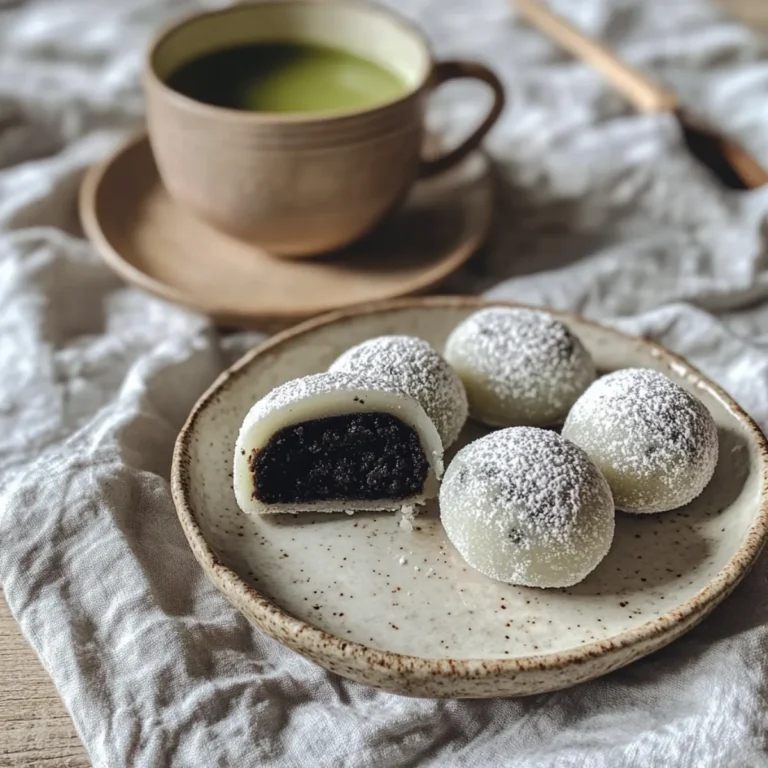
OREO Mochi: The Ultimate Dessert Fusion You Didn’t Know You Needed
A chewy, chocolatey fusion dessert that brings together the creamy crunch of OREO cookies and the soft, stretchy goodness of Japanese mochi.
- Total Time: 25 minutes
- Yield: 10 mochi balls 1x
Ingredients
- 1 cup sweet rice flour (Mochiko or Shiratamako)
- 1/4 cup granulated sugar
- 3/4 cup milk (or non-dairy milk like almond or oat)
- 1/4 teaspoon alcohol-free vanilla extract
- Cornstarch or potato starch (for dusting)
- 10 OREO cookies, crushed (separate cream and cookie if preferred)
- 2 tablespoons cream cheese (optional, for creamy filling)
- Crushed roasted almonds or toasted coconut flakes (optional)
Instructions
- Crush OREOs and mix with cream cheese or the separated cream filling. Scoop into teaspoon-sized balls and freeze for 15–20 minutes.
- In a microwave-safe bowl, mix sweet rice flour, sugar, milk, and vanilla extract until smooth.
- Microwave for 1 minute, stir, then microwave for 30 seconds twice more, stirring each time, until it forms a sticky dough. Alternatively, steam for 15–20 minutes, stirring once halfway through.
- Dust your hands and work surface with cornstarch. Scoop a tablespoon of dough, flatten it, place frozen filling in center, and pinch dough around it to seal.
- Repeat until all mochi balls are shaped.
- Place on parchment and chill for 15–30 minutes before serving cold or at room temperature.
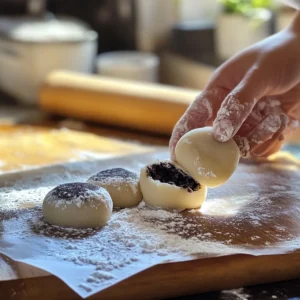
Notes
Freeze the OREO filling beforehand to make stuffing easier and reduce mess. Try swapping dairy milk for almond or oat milk for a vegan-friendly twist.
- Prep Time: 20 minutes
- Cook Time: 5 minutes
- Category: Dessert
- Method: Microwave
- Cuisine: Fusion
- Diet: Vegetarian
Nutrition
- Serving Size: 1 mochi ball
- Calories: 120
- Sugar: 8g
- Sodium: 85mg
- Fat: 4.5g
- Saturated Fat: 2g
- Unsaturated Fat: 2g
- Trans Fat: 0g
- Carbohydrates: 18g
- Fiber: 0.5g
- Protein: 1.5g
- Cholesterol: 5mg
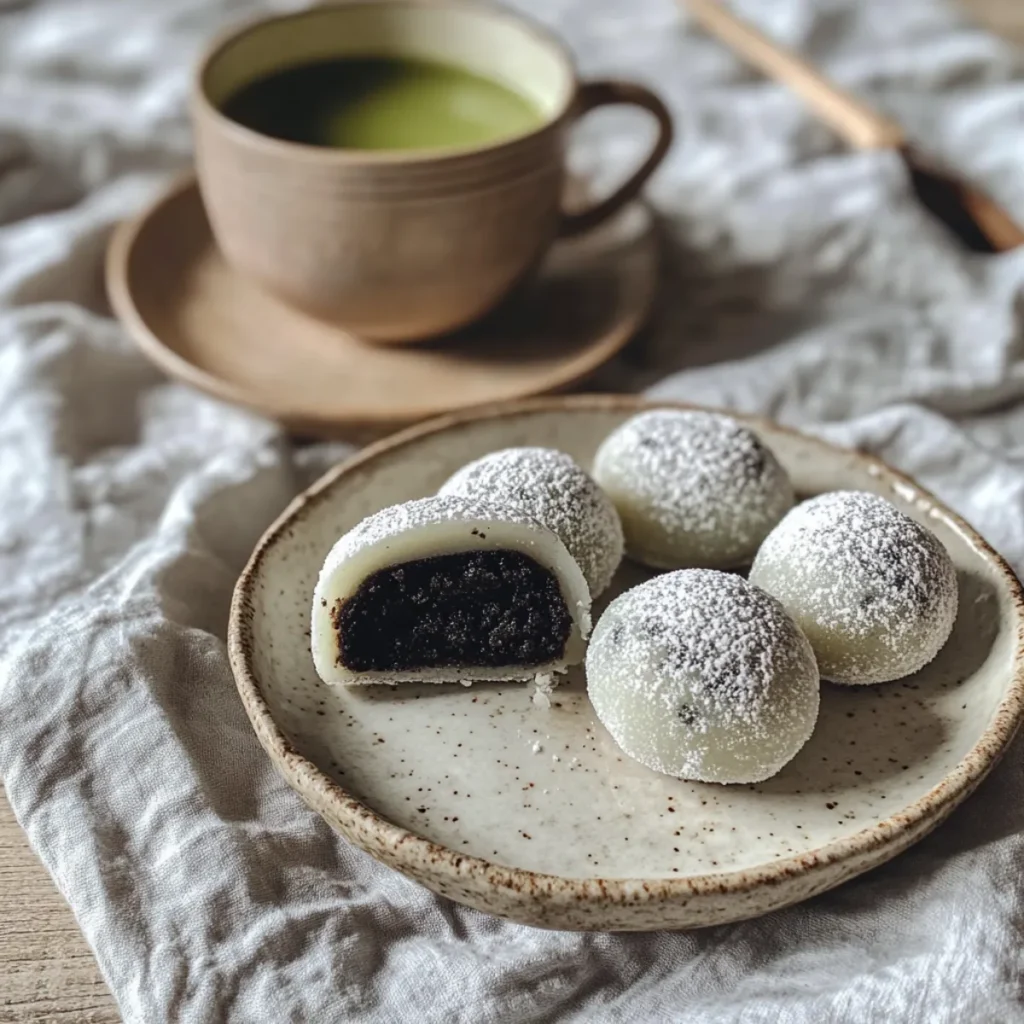

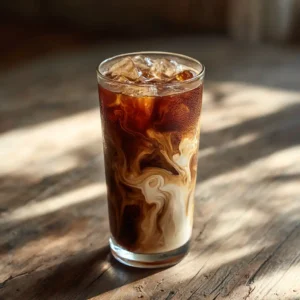





8 thoughts on “OREO Mochi: The Ultimate Dessert Fusion You Didn’t Know You Needed”